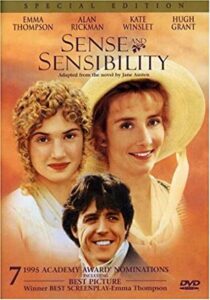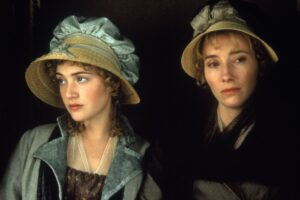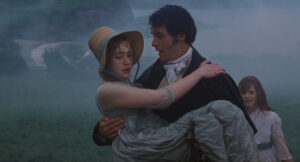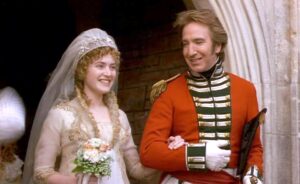“Sense and Sensibility” – Two Faces of Feminity

Title: “Sense and Sensiblity”
Release Date: 1995
Director: Ang Lee
Cast: Emma Thompson, Kate Winslet, Hugh Grant, Alan Rickman, Greg Wise, Gemma Jones, Emilie Francois, Harriet Walter
Each novel of Jane Austen is a masterpiece, hence its screen adaptation is a great challenge for a director. Ang Lee’s take on “Sense and Sensibility” makes for an interesting film, with a cast of great actors and a tight, well-composed plot. Just like in the original text, women are in the foreground here, especially the relationship between the sisters. At the same time, “Sense and Sensibility” has been interpreted through the prism of contemporary culture: it contains elements of feminism, but also – unlike Jane Austen – it stands on the side of the romantic vision of the world and love.
An adaptation of Jane Austen’s seemingly British novel from 1811, “Sense and Sensibility” was made by a director of Taiwanese descent. It might seem, therefore, that the effect will be bizarre, and yet it is not – Ang Lee’s picture is a well-conceived whole with great acting performances and the heritage of the English empire intact. Admittedly, this was largely due to Emma Thompson, author of the Oscar-winning screenplay for the film, as well as the lead (Golden Globe and BAFTA-winning) role of Elinor.
The film also won the Golden Globe for Best Drama, and the BATFA Award went to Emma Thompson, Kate Winslet for Best Supporting Actress and Ang Lee for Best Picture. The director was also awarded the Golden Bear. “Sense and Sensibility” turned out to be a great cinematic success and was warmly welcomed by audiences all over the world.

“Sense and Sensibility” – Jane Austen’s vision through the lens of modern times
The adaptation of the novel for the needs of the film was obviously connected with some changes in relation to the original text by Jane Austen which turned out to be significant. While the vision of the 19th century writer is strongly rooted in the realism of the time and focuses mainly on the social dimension of a woman’s situation and marriage, the film emphasizes mainly the romantic aspects of the story, though it also has some distinct feminist accents. Therefore, Ang Lee’s picture accurately shows contemporary cultural trends and at the same time clearly reaches for the clichés of popular culture, especially referring to Hollywood cinema.
The plot of “Sense and Sensibility” is set in the late 18th century. Elinor, Marianne, and Margaret are three sisters who, after their father’s death as a result of an unfavorable provision in his will, must leave the family estate in Norhland with their mother and move to a modest cottage in another county given to them by a wealthy relative. The Dashwood estate, meanwhile, falls to their half-brother and his wife Fanny. The sisters have completely different dispositions: Elinor is a steady, prudent maiden who hides her feelings under a mask of calmness and convention, Marianne, on the other hand, is an unusually vivid idealist, in love with fiery literature and immersed in dreams of great love.
Both heroines fall in love with young, handsome men: Elinor in her sister-in-law’s brother Edward, while Marianne in the handsome and gallant Mr. Willoughby. Both of them also experience painful disappointment in love – although they experience it quite differently: modest Elinor hides her feelings, while eccentric Marianne suffers like a heroine from famous romances. After many twists and turns, things finally work out for the best and the two sisters are happily married.

Ang Lee’s film definitely emanates romance more than Jane Austen’s novel and reaches for characteristic clichés taken from popular culture. Willoughby in the cinematic version is a romantic prince who rides in on a white horse and rescues Marianne from trouble when she twists her ankle. He also takes off the lady’s slipper to check the condition of her foot, which is a reference to the Cinderella fairy tale. In the novel, Willoughby meets Miss Dashwood while walking and there is no physical contact (except for bringing Marianne home, of course). On the other hand, the character of Captain Brandon, the heroine’s later husband, is built not only in opposition to Willoughby’s treacherous seducer, but also has clear characteristics in common with the bachelor. The scene in which he brings the rain-soaked Marianne in his arms (she is missing from the novel) is a clear repetition of the situation with her first love object, suggesting that he possesses all the qualities of his rival and, moreover, surpasses him in the constancy of his feelings for his beloved.
“Sense and Sensibility” – contemporary vision of masculinity and femininity
It is significant, then, that the movie “Sense and Sensibility” presents a vision of masculinity that differs from Austen’s. We are dealing here with a conception of masculinity that is so different from Austen’s. We are dealing here with the concept of the so-called “new man,” that is, not a cool gentleman whose strengths are reduced to intellectual (and, of course, material) advantages. For example, Edward plays with Margaret, Colonel Brandon reads poetry to Marianne, and during her illness he almost faints from fear for his beloved.
What is most significant, however, is that the men in the film version of “Sense and Sensibility” are extremely physically attractive. The women, on the other hand, do not attract attention with their stunning beauty. This is an important message about a cultural shift: male physicality is much more important to women today than it used to be. As for the fairer sex, the relegation of their beauty to the background suggests that women’s intellectual qualities are finally getting the recognition they deserve. The men are also much more idealized than in Jane Austen’s novels, which often employ a biting irony in their portrayal. Edward, despite his ambiguous relationship with Elinor (he is, after all, engaged and openly flirts with her), is thus much more justified, and Colonel Brandon much more magnanimous than in the novel.

“Sense and Sensibility” – the heroines – both in the novel and in the film
“Sense and Sensibility” – display an active attitude, the most prominent sign of which is the constant walking of the ladies and the travels they undertake. This also applies to their fate – Marianne and Elinor, despite being trapped in the tight framework of patriarchy and dependent on men, want to decide about their lives and make their own decisions. This is particularly evident in the case of Margaret, the youngest of the sisters, who uses the privilege of her childhood to dream about distant travels, climb trees and hide under the table when she does not feel like talking to someone. Margaret is not yet subject to the demands of social conventions, so she is free – becoming a phantasm of feminine liberation to which modern women still aspire.
“Sense and Sensibility” openly criticizes the plight of women in patriarchy, the most glaring example being the loss of her own home by Mrs. Dashwood and her three daughters to a male heir. In this regard, the focus of the film is clearer than in the novel. For the book presents a much more complicated version of the events by which the Dashwood ladies’ brother inherits Norhland. In this regard, the film “Sense and Sensibility” contains feminist accents, becoming a statement on the low position of women in society.
The moderate feminism of “Sense and Sensibility”
The feminist accents in “Sense and Sensibility” are not very radical, however. Apart from the criticism of patriarchal models, we find a vision of the world in which love appears as the most important human need. A man becomes the complement of a woman’s personality and her stable support. In this respect, the story of Marianne, shown slightly differently in the film and in the book, is significant. In the novel, the heroine’s illness becomes a metaphor for a “romantic fever” that can lead a woman to her doom. Marianne wakes up from the maligna as a different person – mature, self-conscious, and above all, ready to live independently, though of course within the boundaries of the female community. The special bond between Marianne and Elinor, as well as their relationship with her mother, are very well played out in the film.

In Austen’s novel, love for Brandon is not a simple substitute for love for Willoughby. On the contrary, Marianne marries the colonel out of reason and affection, and love only comes later. The wedding of this couple is not the climax of the story, but is mentioned only in a few words. This is quite different from the film, which clearly uses the patterns of Hollywood romance here. Colonel Brandon appears to be Marianne’s savior, which is already announced by a scene from the beginning of the film in which he lends her his knife so that she can cut off the hard cane after unsuccessful attempts – thanks to it the heroine will free herself from her painful past. When Marianne recovers from her illness, the colonel quickly wins her heart, and then as her beloved, leads the girl to the altar.
Willoughby, on the other hand, watches with sorrow from the hilltop house where Marianne lives with her husband, which can be read as his unrelieved pain at the loss of his love. Meanwhile, Jane Austen ironically describes this gentleman’s shallow grief: “But that he was for ever inconsolable, that he fled from society, or contracted an habitual gloom of temper, or died of a broken heart, must not be depended on – for he did neither. He lived to exert, and frequently to enjoy himself,” the author writes.
Sense or Sensibility?
The adaptation of Jane Austen’s novel is therefore much more romantic in spirit than the original, yet it seems to be a very successful film. The writer herself, who was clearly closer to a realistic and ironic approach to life, did not ultimately discredit either of the attitudes: sensible or romantic. Rather, she searched for the golden mean between the two, which is reflected in the metamorphosis of the main characters: Marianne finds maturity and prudence in herself, while the steady Elinor reveals great reserves of romanticism, and even fails to control herself when Edward comes to ask her to marry him.
Many critics have pointed to the romanticism of Ang Lee’s adaptation as a flaw: a misappropriation of Austen’s text and a passive copying of the love story code. Perhaps, nevertheless, this approach to love is closer to contemporary audiences, especially women – the free choice of a life partner has become one of the fundamental changes in contemporary culture. Moreover, the negation of all manifestations of the love story pattern seems to be contrary to the spirit of Jane Austen’s prose, who, though she created “anti-romances”, was always about love, and, what is more, fiercely fought against the harmful division into high and low literature. In her time, the latter consisted of novels (!) contemptuously treated as reading material for ladies with poor taste. In a postmodern work, however, the elite and the masses are mixed, and in this case the effect is very satisfying.
Literature:
A. Niemczyńska, “Kino kobiet? Pomiędzy romantyzmem a feminizmem – adaptacje powieści Jane Austen lat dziewięćdziesiątych”, Kraków 2011.
